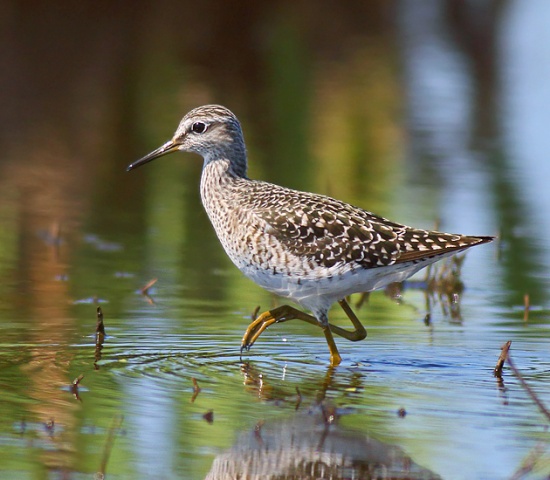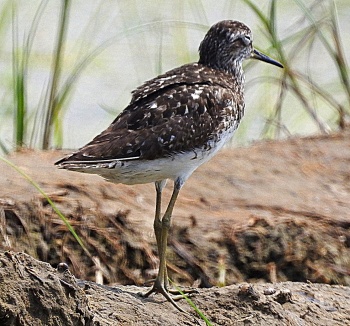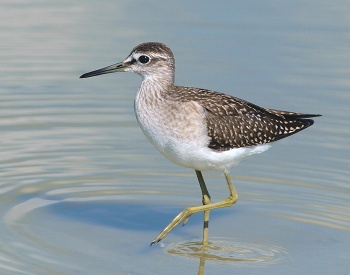Nutcracker (talk | contribs) m (typo) |
Aloktewari (talk | contribs) (copyright symbol to images) |
||
| Line 1: | Line 1: | ||
| − | [[Image:Tringa glareola, West Sweden.jpg|thumb|550px|right|Adult breeding plumage<br />Photo by {{user|Digiscoper321|Digiscoper321}}<br />Western [[Sweden]], May 2016 ]] | + | [[Image:Tringa glareola, West Sweden.jpg|thumb|550px|right|Adult breeding plumage<br />Photo © by {{user|Digiscoper321|Digiscoper321}}<br />Western [[Sweden]], May 2016 ]] |
;[[:Category:Tringa|Tringa]] glareola | ;[[:Category:Tringa|Tringa]] glareola | ||
==Identification== | ==Identification== | ||
| − | [[Image:wood sandpiper.jpg|thumb|350px|right|Adult in worn plumage post-breeding<br />Photo by {{user|Alok+Tewari|aloktewari}}<br />Delhi, [[India]], July 2016 ]] | + | [[Image:wood sandpiper.jpg|thumb|350px|right|Adult in worn plumage post-breeding<br />Photo © by {{user|Alok+Tewari|aloktewari}}<br />Delhi, [[India]], July 2016 ]] |
Length 19–23 cm (7½-9 in), wingspan 34–37 cm, weight 34–98 g<br /> | Length 19–23 cm (7½-9 in), wingspan 34–37 cm, weight 34–98 g<br /> | ||
A fairly small, long-legged wader with a rather attenuated 'necky' appearance. It has brown upperparts spangled with white, and generally white underparts, with light brown barring or mottling on the flanks and breast.<br /> | A fairly small, long-legged wader with a rather attenuated 'necky' appearance. It has brown upperparts spangled with white, and generally white underparts, with light brown barring or mottling on the flanks and breast.<br /> | ||
| Line 11: | Line 11: | ||
====Similar Species==== | ====Similar Species==== | ||
| − | [[Image:Tringa glareola, juvenile, Romania.jpg|thumb|350px|right|Juvenile<br />Photo by {{user|Cristian+Mihai|Cristian Mihai}}<br />Vadu, Constanţa, [[Romania]], August 2014 ]] | + | [[Image:Tringa glareola, juvenile, Romania.jpg|thumb|350px|right|Juvenile<br />Photo © by {{user|Cristian+Mihai|Cristian Mihai}}<br />Vadu, Constanţa, [[Romania]], August 2014 ]] |
[[Green Sandpiper]] is broadly similar but differs in slightly stockier build with shorter neck and legs, more contrasting plumage, darker above and whiter below, and in flight black underwings; confusion is most likely with adult Wood Sandpipers late in the summer which can become very dark above as the white spots wear off. Juvenile [[Common Redshank]] is also a frequent confusion species, as it has duller, more orangey legs and a shorter bill than adults. [[Lesser Yellowlegs]] has quite similar plumage, though the [[Topography#Heads|supercilia]] are bolder, and its legs brighter chrome yellow. | [[Green Sandpiper]] is broadly similar but differs in slightly stockier build with shorter neck and legs, more contrasting plumage, darker above and whiter below, and in flight black underwings; confusion is most likely with adult Wood Sandpipers late in the summer which can become very dark above as the white spots wear off. Juvenile [[Common Redshank]] is also a frequent confusion species, as it has duller, more orangey legs and a shorter bill than adults. [[Lesser Yellowlegs]] has quite similar plumage, though the [[Topography#Heads|supercilia]] are bolder, and its legs brighter chrome yellow. | ||
==Distribution== | ==Distribution== | ||
Revision as of 13:57, 26 August 2019
- Tringa glareola
Identification
Length 19–23 cm (7½-9 in), wingspan 34–37 cm, weight 34–98 g
A fairly small, long-legged wader with a rather attenuated 'necky' appearance. It has brown upperparts spangled with white, and generally white underparts, with light brown barring or mottling on the flanks and breast.
The most striking plumage features are the buffy-white supercilium, which shows well behind the eye, and the square white rump. The supercilium is defined by a dark brown 'cap' and a bold broad eye-stripe.
The legs are dull yellowish, but can appear quite dark when the bird is feeding in mud, or in dull light. The bill is about the same length as the head, and straight, blackish-brown with a slightly paler greenish-grey base. The head shape is almost squarish in profile, and the neck can be extended or retracted a certain amount, changing the overall appearance. The white rump has a patch between the dark tip of the tail and the back.
Winter plumage and juvenile are similar to summer plumage, but slightly duller; on juveniles the spots on the mantle and wings are pale buff rather than white, and the flank markings diffuse rather than barred.
Similar Species
Green Sandpiper is broadly similar but differs in slightly stockier build with shorter neck and legs, more contrasting plumage, darker above and whiter below, and in flight black underwings; confusion is most likely with adult Wood Sandpipers late in the summer which can become very dark above as the white spots wear off. Juvenile Common Redshank is also a frequent confusion species, as it has duller, more orangey legs and a shorter bill than adults. Lesser Yellowlegs has quite similar plumage, though the supercilia are bolder, and its legs brighter chrome yellow.
Distribution
Breeds in northern Europe and northern Asia; winters in southern Africa, southern Asia and Australia; on migration west to Ireland (rare) and Great Britain. A vagrant in North America, most frequent in western Alaska, where annual on migration.
Taxonomy
This is a monotypic species[1].
Habitat
Well-vegetated freshwater wetlands, often in woodland though less tied to forests than Green Sandpiper and common in wet meadows. On passage and in winter at more open pools and marshes on muddy margins or in short wet vegetation. Rarely found in saline or tidal habitats.
Behaviour
Wood Sandpiper tends to be a rather active bird, often found on the margins of quite small pools, or wading hurriedly through the shallows. It often teeters in the manner of a Common Sandpiper, though perhaps not quite so frequently. As it advances it pecks briefly to one side or the other, picking up tiny particles of food from the surface of the mud.
Strongly territorial in the breeding season. Solitary or in small flocks on passage and in winter, though larger flocks may occur in favoured habitats in winter. One of the most numerous waders in the Old World, with a breeding population of several million pairs.
Diet
The diet includes insects, worms, spiders, shellfish and small fish.
Breeding
Nests either in a scrape on the ground, or in old thrush nests in trees. The 4 eggs are are incubated for 22-23 days by the female. The young fledge after 29-31 days.
Vocalisation
<flashmp3>Tringa glareola (song).mp3</flashmp3>
Listen in an external program
Gallery
Click on photo for larger image
Winter plumage
Photo by Peter Duymelinc
Luxor, Egypt, January 2005
References
- Clements, J. F., T. S. Schulenberg, M. J. Iliff, D. Roberson, T. A. Fredericks, B. L. Sullivan, and C. L. Wood. 2017. The eBird/Clements checklist of birds of the world: v2017, with updates to August 2017. Downloaded from http://www.birds.cornell.edu/clementschecklist/download/
- RSPB
- Handbook of the Birds of the World Alive (retrieved May 2014)
- Wikipedia
- BTO Bird Facts
Recommended Citation
- BirdForum Opus contributors. (2025) Wood Sandpiper. In: BirdForum, the forum for wild birds and birding. Retrieved 4 April 2025 from https://www.birdforum.net/opus/Wood_Sandpiper
External Links








